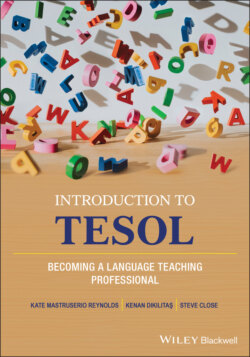Читать книгу Introduction to TESOL - Kate Reynolds - Страница 25
Council of Europe Framework proficiency scale
ОглавлениеCouncil of Europe Framework (CEFR) has six levels of proficiency that are correlated to the ACTFL Proficiency Scale (Council of Europe, n.d.). The CEFR scale ranges from Basic (A level) to Independent (B level) and Proficient User (C level) of the language. At each level is a lower and upper tier indicated by 1 or 2. At the most basic level is A1 (see Table 1.3). A language learner at A1 would be able to hold basic conversations about themselves with help. The CEFR is used in Europe and many international contexts.
Table 1.3 Council of Europe Framework
| Proficient User | C2 | Can understand with ease virtually everything heard or read. Can summarize information from different spoken and written sources, reconstructing arguments and accounts in a coherent presentation. Can express him/herself spontaneously, very fluently and precisely, differentiating finer shades of meaning even in more complex situations. |
| C1 | Can understand a wide range of demanding, longer texts, and recognize implicit meaning. Can express him/herself fluently and spontaneously without much obvious searching for expressions. Can use language flexibly and effectively for social, academic and professional purposes. Can produce clear, well-structured, detailed text on complex subjects, showing controlled use of organizational patterns, connectors and cohesive devices. | |
| Independent User | B2 | Can understand the main ideas of complex text on both concrete and abstract topics, including technical discussions in his/her field of specialization. Can interact with a degree of fluency and spontaneity that makes regular interaction with native speakers quite possible without strain for either party. Can produce clear, detailed text on a wide range of subjects and explain a viewpoint on a topical issue giving the advantages and disadvantages of various options. |
| B1 | Can understand the main points of clear standard input on familiar matters regularly encountered in work, school, leisure, etc. Can deal with most situations likely to arise whilst travelling in an area where the language is spoken. Can produce simple connected text on topics which are familiar or of personal interest. Can describe experiences and events, dreams, hopes & ambitions and briefly give reasons and explanations for opinions and plans. | |
| Basic User | A2 | Can understand sentences and frequently used expressions related to areas of most immediate relevance (e.g., very basic personal and family information, shopping, local geography, employment). Can communicate in simple and routine tasks requiring a simple and direct exchange of information on familiar and routine matters. Can describe in simple terms aspects of his/her background, immediate environment and matters in areas of immediate need. |
| A1 | Can understand and use familiar everyday expressions and very basic phrases aimed at the satisfaction of needs of a concrete type. Can introduce him/herself and others and can ask and answer questions about personal details such as where he/she lives, people he/she knows and things he/she has. Can interact in a simple way provided the other person talks slowly and clearly and is prepared to help. | |
| Used with permission from Council of Europe. |
Proficiency scales do not necessarily indicate how long each level will take, with the exception of the CEFR. Some levels will not be achieved by some learners. Learners may also stagnate or step down on the scale without effort to improve their language abilities.
As you read this text, you will find many references to language proficiency levels. These will be general references, unless otherwise noted.
